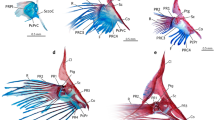Summary
The leatherjacket (Parika scaber) swims by means of its well developed dorsal and anal fins using balistiform locomotion. The fibre-composition of the muscles controlling these fins, and the composition of the myotomal trunk muscle, have been studied by electron microscopy and histochemistry. The myotome contains essentially only a single muscle-type (white) used for high-speed sprinting, but the fin muscles are composed of three fibre-types: red, pink and white. The significance of these differences in relation to the locomotion of this species is discussed.
Similar content being viewed by others
References
Adolfsson J, Ljungqvist A, Tornling G, Unge G (1981) Capillary increase in the skeletal muscle of trained young and adult rats. J Physiol 310:529–532
Barany M (1967) ATPse activity of myosin correlated with speed of muscle shortening. J Gen Physiol 50:197–218
Bilinski E (1974) Biochemical aspects of fish swimming. In: Malins DC, Sargent JR (eds) Biochemical and biophysical perspectives in marine biology. Academic Press London 1:239–288
Black EC, Conner AR, Lam KC, Chiu WG (1962) Changes in glycogen, pyruvate and lactate in rainbow trout (Salmo gairdneri) during and following muscular activity. J Fish Res Bd Canada 19:409–436
Blake RW (1978) On balistiform locomotion. J Mar Biol Ass UK 58:73–80
Blake RW (1983) Median and paired fin propulsion. In: Webb PW, Weihs D (eds) Fish Biomechanics. Praeger New York, pp 214–247
Boddeke R, Slipjer EJ, van der Stelt (1959) Histological characteristics of the body musculature of fishes in connection with their mode of life. Proc Konink Ned Akad Wet 62:576–588
Bone Q (1966) On the function of the two types of myotomal muscle fibre in elasmobranch fish. J Mar Biol Assn UK 46:321–349
Bone Q (1978) Locomotor muscles. In: Hoar WS, Randall DJ (eds) Fish Physiology vol VII Academic Press New York, pp 361–424
Bone Q, Kiceniuk J, Jones DR (1978) On the role of the different fibre types in fish myotomes at intermediate swimming speeds. Fish Bull 76:691–699
Davison W (1983a) The lateral musculature of the common bully,Gobiomorphus cotidianus, a freshwater fish from New Zealand. J Fish Biol 23:143–151
Davison W (1983b) Changes in muscle cell ultrastructure following exercise inSalmo trutta. Experentia 39:1017–1018
Davison W, Goldspink G (1984) The cost of swimming for two teleost fish. NZ J Zool 11:225–232
Davison W, Macdonald JA (1985) A histochemical study of the swimming muscles of antarctic fish. NZ J Zool 12:473–483
Flood PR (1968) Structure of the segmental trunk muscle inAmphioxus. Z Zellforsch 84:389–416
Flood PR (1973) The skeletal muscle fibre types ofMyxine glutinosa L related to those of other chordates. Acta Reg Soc Sci Litt Gothoburg Zool 8:17–20
Flood PR (1979) The vascular supply of three fibre types in the parietal trunk muscle of the Atlantic hagfish (Myxine glutinosa L.) A light microscopic quantitative analysis and an evaluation of various methods to express capillary density relative to fibre types. Microvasc Res 17:55–70
Gray J (1968) Animal locomotion. Weidenfield and Nicolson London, pp 18–83
Guth L, Samaha FJ (1970) Procedure for the histochemical demonstraton of actomyosin ATPase. Exptl Neurol 28:365–367
Hudson RCL (1973) On the role of the white muscles in teleosts at intermediate swimming speeds. J Exp Biol 58:509–522
Johnston IA (1980) Specialisation of fish muscle. In: Development and specialisation of muscle. S E B seminar series 7:123–148
Johnston IA (1981) Structure and function of fish muscles. Symp Zoo Soc London 48:71–113
Johnston IA (1983) Dynamic properties of fish muscle. In: Webb PW, Weihs D (eds) Fish Biomechanics Praeger New York, pp 36–67
Johnston IA, Moon W (1980) Exercise training in skeletal muscle of brook trout (Salvelinus fontinalis). J Exp Biol 87:177–194
Johnston IA, Frearson N, Goldspink G (1973) Myofibrillar AT-Pase activities of red and white myotomal muscle of marine fish. Experentia 28:713–714
Johnston IA, Davison W, Goldspink G (1977) Energy metabolism of carp swimming muscles. J Comp Physiol 114:203–216
Kilarski W, Smialowska E, Friedhuber A (1982) Histological analysis of fibres in myotomes of antarctic fish. II Morphometry of muscle fibres and capillaries. Z Mikrosk Anat Forsch 96:791–801
Kilarski W, Kozlowska M (1984) The nerve fibre endings as a morphological basis for classification of fish muscle fibres. Folia Histochem Cytochem 22:122–123
Korneliussen H, Nicolaysen K (1973) Ultrastructure of four types of striated muscle fibers in the Atlantic hagfish (Myxine glutinosa L.). Z Zellforsch 143:273–290
Love RM (1970) The chemical biology of fishes. Academic Press, London
Love RM (1980) The chemical biology of fishes: advances 1968–1977. Academic Press, London
Nachlas MM, Tsou KC, de Sonze E, Cheng C-S, Seligman AM (1957) Cytochemical demonstration of succinic dehydrogenase by the use of a new p-nitro phenyl substituted ditetrazole. J Histochem Cytochem 5:420–436
Quaglia A (1980) Ultrastructural and morphometric studies on the axial muscles of the grey mulletMugil cephalus L. (Pisces, Perciformes). 1. Organisation of muscle fibres. Boll Zool 47:75–82
Rockstein M, Herron PW (1951) Phosphatase in the adult worker honey bee. J Cell Comp Physiol 38:451–479
te Kronnie G, Tatarczuch L, van Raamsdonk W, Kilarski W (1983) Muscle fibre types in the myotome of the sticklebackGasterosteus aculeatus L., a histochemical immunohistochemical and ultrastructural study. J Fish Biol 22:303–316
Totland GK, Kryvi H, Bone Q, Flood PR (1981) Vascularisation of the lateral muscle of some elasmobranchiomorph fishes. J Fish Biol 18:223–234
Walesby NJ, Johnston IA (1980) Fibre types in the locomotory muscles of an antarctic teleostNotothenia rossii. Cell Tissue Res 208:143–164
Webb PW (1973) Kinematics of pectoral fin propulsion inCymatogaster aggregata. J Exp Biol 59:697–710
Author information
Authors and Affiliations
Rights and permissions
About this article
Cite this article
Davison, W. The median fin muscles of the leatherjacket,Parika scaber (Pisces: Balistidae). Cell Tissue Res. 248, 131–135 (1987). https://doi.org/10.1007/BF01239973
Accepted:
Issue Date:
DOI: https://doi.org/10.1007/BF01239973




